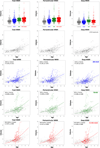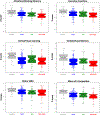Age-Accelerated Increase of White Matter Hyperintensity Volumes Is Exacerbated by Heavy Alcohol Use in People Living With HIV
- PMID: 37597798
- PMCID: PMC10840832
- DOI: 10.1016/j.biopsych.2023.07.023
Age-Accelerated Increase of White Matter Hyperintensity Volumes Is Exacerbated by Heavy Alcohol Use in People Living With HIV
Abstract
Background: Antiretroviral treatment has enabled people living with HIV infection to have a near-normal life span. With longevity comes opportunities for engaging in risky behavior, including initiation of excessive drinking. Given that both HIV infection and alcohol use disorder (AUD) can disrupt brain white matter integrity, we questioned whether HIV infection, even if successfully treated, or AUD alone results in signs of accelerated white matter aging and whether HIV+AUD comorbidity further accelerates brain aging.
Methods: Longitudinal magnetic resonance imaging-FLAIR data were acquired over a 15-year period from 179 control individuals, 204 participants with AUD, 70 participants with HIV, and 75 participants with comorbid HIV+AUD. White matter hyperintensity (WMH) volumes were quantified and localized, and their functional relevance was examined with cognitive and motor testing.
Results: The 3 diagnostic groups each had larger WMH volumes than the control group. Although all 4 groups exhibited accelerating volume increases with aging, only the HIV groups showed faster WMH enlargement than control individuals; the comorbid group showed faster acceleration than the HIV-only group. Sex and HIV infection length, but not viral suppression status, moderated acceleration. Correlations emerged between WMH volumes and attention/working memory and executive function scores of the AUD and HIV groups and between WMH volumes and motor skills in the 3 diagnostic groups.
Conclusions: Even treated HIV can show accelerated aging, possibly from treatment sequelae or legacy effects, and notably from AUD comorbidity. WMH volumes may be especially relevant for tracking HIV and AUD brain health because each condition is associated with liability for hypertensive processes, for which WMHs are considered a marker.
Keywords: Aging; Alcohol; Brain; Cognition; HIV infection; White matter hyperintensity.
Copyright © 2023 Society of Biological Psychiatry. Published by Elsevier Inc. All rights reserved.
Conflict of interest statement
The authors report no biomedical financial interests or potential conflicts of interest.
Figures





Similar articles
-
Serum albumin and white matter hyperintensities.Transl Psychiatry. 2024 Jun 1;14(1):233. doi: 10.1038/s41398-024-02953-5. Transl Psychiatry. 2024. PMID: 38824150 Free PMC article.
-
Anterior and posterior thalamic volumes differentially correlate with memory, attention, and motor processes in HIV infection and alcohol use disorder comorbidity.Brain Res Bull. 2024 Oct 15;217:111085. doi: 10.1016/j.brainresbull.2024.111085. Epub 2024 Sep 27. Brain Res Bull. 2024. PMID: 39343322
-
White matter hyperintensities correlate to cognition and fiber tract integrity in older adults with HIV.J Neurovirol. 2017 Jun;23(3):422-429. doi: 10.1007/s13365-016-0509-5. Epub 2017 Jan 18. J Neurovirol. 2017. PMID: 28101804 Free PMC article.
-
HIV infection and cerebral small vessel disease are independently associated with brain atrophy and cognitive impairment.AIDS. 2019 Jun 1;33(7):1197-1205. doi: 10.1097/QAD.0000000000002193. AIDS. 2019. PMID: 30870193 Free PMC article.
-
HIV-1 infection and alcohol abuse: neurocognitive impairment, mechanisms of neurodegeneration and therapeutic interventions.Brain Behav Immun. 2011 Jun;25 Suppl 1(Suppl 1):S61-70. doi: 10.1016/j.bbi.2011.03.001. Epub 2011 Mar 21. Brain Behav Immun. 2011. PMID: 21397004 Free PMC article. Review.
Cited by
-
The Interaction Between Cognitive Abilities and White Matter Hyperintensity Phenotypes: A Novel Perspective on Bidirectional Causality.Brain Behav. 2025 Feb;15(2):e70313. doi: 10.1002/brb3.70313. Brain Behav. 2025. PMID: 39925008 Free PMC article.
-
Alcohol Use Disorder and Dementia: A Review.Alcohol Res. 2024 May 23;44(1):03. doi: 10.35946/arcr.v44.1.03. eCollection 2024. Alcohol Res. 2024. PMID: 38812709 Free PMC article. Review.
-
Contributions of cerebral white matter hyperintensities, age, and pedal perception to postural sway in people with HIV.AIDS. 2024 Jul 1;38(8):1153-1162. doi: 10.1097/QAD.0000000000003894. Epub 2024 Mar 27. AIDS. 2024. PMID: 38537080 Free PMC article.
-
Contributions of Cerebral White Matter Hyperintensities to Postural Instability in Aging With and Without Alcohol Use Disorder.Biol Psychiatry Cogn Neurosci Neuroimaging. 2024 Oct;9(10):998-1009. doi: 10.1016/j.bpsc.2024.03.005. Epub 2024 Apr 1. Biol Psychiatry Cogn Neurosci Neuroimaging. 2024. PMID: 38569932
-
Aging, HIV infection, and alcohol exert synergist effects on regional thalamic volumes resulting in functional impairment.Neuroimage Clin. 2024;44:103684. doi: 10.1016/j.nicl.2024.103684. Epub 2024 Oct 12. Neuroimage Clin. 2024. PMID: 39423567 Free PMC article.
References
-
- UNAIDS (2022): Fact Sheet. In: UNAIDS, editor. https://wwwunaidsorg/en/resources/fact-sheet.
-
- CDC (2020): HIV Surveillance Report. Center For Disease Control And Prevention.
-
- Weber T (2008): Progressive multifocal leukoencephalopathy. Neurol Clin. 26:833–854, x-xi. - PubMed
-
- Kirwan PD, Chau C, Brown AE, Gill ON, Delpech VC (2016): HIV in the UK 2016 Report. London, UK: Public Health England.
Publication types
MeSH terms
Grants and funding
LinkOut - more resources
Full Text Sources
Medical

